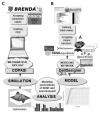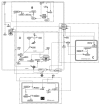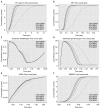In Silico Model-driven Assessment of the Effects of Brain-derived Neurotrophic Factor Deficiency on Glutamate and Gamma-Aminobutyric Acid: Implications for Understanding Schizophrenia Pathophysiology
- PMID: 28449558
- PMCID: PMC5426484
- DOI: 10.9758/cpn.2017.15.2.115
In Silico Model-driven Assessment of the Effects of Brain-derived Neurotrophic Factor Deficiency on Glutamate and Gamma-Aminobutyric Acid: Implications for Understanding Schizophrenia Pathophysiology
Abstract
Objective: Deficient brain-derived neurotrophic factor (BDNF) is one of the important mechanisms underlying the neuroplasticity abnormalities in schizophrenia. Aberration in BDNF signaling pathways directly or circuitously influences neurotransmitters like glutamate and gamma-aminobutyric acid (GABA). For the first time, this study attempts to construct and simulate the BDNF-neurotransmitter network in order to assess the effects of BDNF deficiency on glutamate and GABA.
Methods: Using CellDesigner, we modeled BDNF interactions with calcium influx via N-methyl-D-aspartate receptor (NMDAR)- Calmodulin activation; synthesis of GABA via cell cycle regulators protein kinase B, glycogen synthase kinase and β-catenin; transportation of glutamate and GABA. Steady state stability, perturbation time-course simulation and sensitivity analysis were performed in COPASI after assigning the kinetic functions, optimizing the unknown parameters using random search and genetic algorithm.
Results: Study observations suggest that increased glutamate in hippocampus, similar to that seen in schizophrenia, could potentially be contributed by indirect pathway originated from BDNF. Deficient BDNF could suppress Glutamate decarboxylase 67-mediated GABA synthesis. Further, deficient BDNF corresponded to impaired transport via vesicular glutamate transporter, thereby further increasing the intracellular glutamate in GABAergic and glutamatergic cells. BDNF also altered calcium dependent neuroplasticity via NMDAR modulation. Sensitivity analysis showed that Calmodulin, cAMP response element-binding protein (CREB) and CREB regulated transcription coactivator-1 played significant role in this network.
Conclusion: The study presents in silicoquantitative model of biochemical network constituting the key signaling molecules implicated in schizophrenia pathogenesis. It provides mechanistic insights into putative contribution of deficient BNDF towards alterations in neurotransmitters and neuroplasticity that are consistent with current understanding of the disorder.
Keywords: Brain-derived neurotrophic factor; Computer simulation; Neuronal plasticity; Neurotransmitter agents; Schizophrenia; Signal transduction.
Figures







Similar articles
-
Excitatory actions of GABA increase BDNF expression via a MAPK-CREB-dependent mechanism--a positive feedback circuit in developing neurons.J Neurophysiol. 2002 Aug;88(2):1005-15. doi: 10.1152/jn.2002.88.2.1005. J Neurophysiol. 2002. PMID: 12163549
-
Excitation-transcription coupling via calcium/calmodulin-dependent protein kinase/ERK1/2 signaling mediates the coordinate induction of VGLUT2 and Narp triggered by a prolonged increase in glutamatergic synaptic activity.J Biol Chem. 2010 May 7;285(19):14366-76. doi: 10.1074/jbc.M109.080069. Epub 2010 Mar 8. J Biol Chem. 2010. PMID: 20212045 Free PMC article.
-
Excitatory GABA induces BDNF transcription via CRTC1 and phosphorylated CREB-related pathways in immature cortical cells.J Neurochem. 2014 Oct;131(2):134-46. doi: 10.1111/jnc.12801. Epub 2014 Jul 18. J Neurochem. 2014. PMID: 24965890
-
BDNF-induced local protein synthesis and synaptic plasticity.Neuropharmacology. 2014 Jan;76 Pt C:639-56. doi: 10.1016/j.neuropharm.2013.04.005. Epub 2013 Apr 16. Neuropharmacology. 2014. PMID: 23602987 Review.
-
Shaping synaptic plasticity: the role of activity-mediated epigenetic regulation on gene transcription.Int J Dev Neurosci. 2013 Oct;31(6):359-69. doi: 10.1016/j.ijdevneu.2013.04.003. Epub 2013 May 9. Int J Dev Neurosci. 2013. PMID: 23665156 Review.
Cited by
-
Peripheral Blood Levels of Brain-Derived Neurotrophic Factor in Patients with First Episode Psychosis: A Systematic Review and Meta-Analysis.Brain Sci. 2022 Mar 22;12(4):414. doi: 10.3390/brainsci12040414. Brain Sci. 2022. PMID: 35447946 Free PMC article. Review.
-
Churning Better Transcranial Direct Current Stimulation Outcome with Accelerated Protocols: Understanding the Non-linear Dynamics through Metaplasticity.Clin Psychopharmacol Neurosci. 2025 May 31;23(2):175-183. doi: 10.9758/cpn.24.1243. Epub 2025 Feb 27. Clin Psychopharmacol Neurosci. 2025. PMID: 40223251 Free PMC article. Review.
-
Increased Neutrophil-lymphocyte and Platelet-lymphocyte Ratios in Male Heroin Addicts: A Prospective Controlled Study.Clin Psychopharmacol Neurosci. 2018 May 31;16(2):190-196. doi: 10.9758/cpn.2018.16.2.190. Clin Psychopharmacol Neurosci. 2018. PMID: 29739133 Free PMC article.
-
In the Brain of Phosphodiesterases: Potential Therapeutic Targets for Schizophrenia.Clin Psychopharmacol Neurosci. 2025 Feb 28;23(1):15-31. doi: 10.9758/cpn.24.1229. Epub 2024 Dec 3. Clin Psychopharmacol Neurosci. 2025. PMID: 39820109 Free PMC article. Review.
-
The Ameliorative Effects of Isorhynchophylline on Morphine Dependence Are Mediated Through the Microbiota-Gut-Brain Axis.Front Pharmacol. 2021 Jun 8;12:526923. doi: 10.3389/fphar.2021.526923. eCollection 2021. Front Pharmacol. 2021. PMID: 34168553 Free PMC article.
References
-
- Sayers J. The world health report 2001 — Mental health: new understanding, new hope. Bull World Health Organ. 2001;79:1085.
LinkOut - more resources
Full Text Sources
Other Literature Sources

